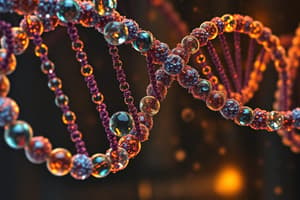Podcast
Questions and Answers
What is Nalidixic Acid considered as?
What is Nalidixic Acid considered as?
- A 4th generation quinolone
- A 3rd generation quinolone
- A 1st generation quinolone (correct)
- A 2nd generation quinolone
What is the main difference between the new fluoroquinolones and ciprofloxacin?
What is the main difference between the new fluoroquinolones and ciprofloxacin?
- They have improved pharmacokinetics
- They are more active against G+ve organisms (correct)
- They are less active against G+ve organisms
- They have a broader spectrum of antimicrobial activity
Why were modifications made to Nalidixic Acid?
Why were modifications made to Nalidixic Acid?
- To increase the incidence of Clostridium difficile infection
- To decrease the spectrum of antimicrobial activity
- To reduce the cost of production
- To expand the spectrum, improve pharmacokinetics, and increase stability against common mechanisms of resistance (correct)
What is a common issue associated with the use of fluoroquinolones?
What is a common issue associated with the use of fluoroquinolones?
What is the mechanism of action of fluoroquinolones?
What is the mechanism of action of fluoroquinolones?
Which enzyme is inhibited by fluoroquinolones in Gram-positive bacteria?
Which enzyme is inhibited by fluoroquinolones in Gram-positive bacteria?
What is the target of fluoroquinolones in Gram-negative bacteria?
What is the target of fluoroquinolones in Gram-negative bacteria?
Which of the following is a type of fluoroquinolone?
Which of the following is a type of fluoroquinolone?
What distinguishes 2nd generation Fluoroquinolones from other generations?
What distinguishes 2nd generation Fluoroquinolones from other generations?
What is unique about the 3rd and 4th generation Fluoroquinolones?
What is unique about the 3rd and 4th generation Fluoroquinolones?
What is the primary target of Fluoroquinolones in bacterial cells?
What is the primary target of Fluoroquinolones in bacterial cells?
Which of the following is a characteristic of Ciprofloxacin?
Which of the following is a characteristic of Ciprofloxacin?
What sets Eukaryotic cells apart from bacterial cells in terms of DNA management?
What sets Eukaryotic cells apart from bacterial cells in terms of DNA management?
What is the primary difference between Nalidixic acid and Norfloxacin?
What is the primary difference between Nalidixic acid and Norfloxacin?
Why are Fluoroquinolones ineffective against eukaryotic cells?
Why are Fluoroquinolones ineffective against eukaryotic cells?
What is unique about the antibacterial spectrum of 2nd generation Fluoroquinolones?
What is unique about the antibacterial spectrum of 2nd generation Fluoroquinolones?
Which generation of fluoroquinolones has poor activity against Pseudomonas aeruginosa?
Which generation of fluoroquinolones has poor activity against Pseudomonas aeruginosa?
Which fluoroquinolone has excellent activity against Streptococcus pneumoniae respiratory infections?
Which fluoroquinolone has excellent activity against Streptococcus pneumoniae respiratory infections?
Which fluoroquinolone is used as an alternative to more toxic drugs such as aminoglycosides?
Which fluoroquinolone is used as an alternative to more toxic drugs such as aminoglycosides?
Which of the following is a characteristic of 2nd generation fluoroquinolones?
Which of the following is a characteristic of 2nd generation fluoroquinolones?
Which fluoroquinolone has 100% bioavailability and is dosed once daily?
Which fluoroquinolone has 100% bioavailability and is dosed once daily?
Which generation of fluoroquinolones has improved activity against atypical organisms and gram-positive bacteria?
Which generation of fluoroquinolones has improved activity against atypical organisms and gram-positive bacteria?
Which fluoroquinolone is used in the treatment of prostatitis due to E-coli?
Which fluoroquinolone is used in the treatment of prostatitis due to E-coli?
Which of the following is a characteristic of 4th generation fluoroquinolones?
Which of the following is a characteristic of 4th generation fluoroquinolones?
Flashcards are hidden until you start studying
Study Notes
Fluoroquinolones
- Fluoroquinolones are derivatives of nalidixic acid, with broad antimicrobial activity, effective for treating various infectious diseases.
- Nalidixic acid is considered a 1st generation quinolone.
Mechanism of Action
- Fluoroquinolones block bacterial DNA replication by inhibiting DNA gyrase in Gram (-ve) bacteria and topoisomerase IV in Gram (+ve) bacteria.
Generations of Fluoroquinolones
- 1st generation: Nalidixic acid
- 2nd generation: Norfloxacin, Ciprofloxacin
- 3rd generation: Levofloxacin
- 4th generation: Moxifloxacin, Gemifloxacin
Antibacterial Spectrum of 2nd Generation Fluoroquinolones
- Norfloxacin and Ciprofloxacin have activity against:
- Aerobic Gram (-ve) bacteria (Pseudomonas aeruginosa, Haemophilus influenzae, Neisseria spp.)
- Atypical bacteria (Chlamydia, Mycoplasma)
- Ciprofloxacin is particularly useful in treating:
- Infections caused by Enterobacteriaceae, Gram (-ve) bacilli, and E-coli
- Typhoid fever caused by Salmonella typhi
- Pseudomonal infections associated with cystic fibrosis
- Traveler's diarrhea and urinary tract infections
Antibacterial Spectrum of 3rd Generation Fluoroquinolones
- Levofloxacin has:
- Expanded activity against Gram (-ve) bacteria
- Improved activity against atypical organisms and Gram (+ve) bacteria
- Excellent activity against S. pneumoniae respiratory infections
- 100% bioavailability and is dosed once daily
- Used in treating:
- Skin infections
- Acute sinusitis
- Acute exacerbation of chronic bronchitis
- Nosocomial pneumonia
- Prostatitis due to E-coli and sexually transmitted diseases (except syphilis)
Antibacterial Spectrum of 4th Generation Fluoroquinolones
- Moxifloxacin has:
- Enhanced activity against Gram (+ve) organisms (e.g., S. pneumoniae)
- Excellent activity against many anaerobes, although resistance to Bacteroides fragilis has been reported
- Poor activity against P. aeruginosa
Studying That Suits You
Use AI to generate personalized quizzes and flashcards to suit your learning preferences.



